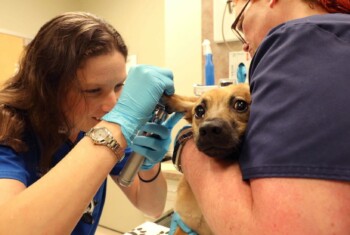Pyoderma: Causes, diagnosis and treatment.
Pyoderma is a bacterial skin infection, which can involve different layers of the skin.
Superficial pyodermas are within the skin near the surface and can often be recognized by the presence of circular crusting lesions or red pimples.
Deep pyodermas occur when bacteria invade structures beneath and beyond the hair follicle. This can be recognized in most cases because pus can be expressed from the skin lesions. Staphylococcus intermedius is considered to be the prime bacterial pathogen of the skin. The bacteria rarely infect normal skin but can if there are injured or inflamed skin surfaces.
Causes.
The development of pyoderma depends upon several factors. The most important is the host’s response to bacterial invasion. Some of the more common causes of recurrent or deep pyodermas are:
- Drug induced (cortisone = steroids)
- Immune deficiency or depression

- Hormonal (hypothyroidism, hyperadrenocorticism)
- Allergic (pollen allergy, food allergy, flea allergy)
- Parasitic (demodicosis, scabies, fleas)
- Keratinization abnormalities (seborrhea)
- Immune-mediated (pemphigus, lupus)
- Fungal (ringworm)
- Staph hypersensitivity (allergy to pet’s own bacteria)
- Neoplasia (cancer)
The prognosis for most superficial pyodermas is good. The deep pyodermas are much more difficult to cure/control. The information gained from the laboratory tests will give us a more precise diagnosis and prognosis. Occasionally, after all of the causes have been eliminated, the pyoderma returns. In these cases, immune-stimulating drugs will be tried.
Diagnosis.
The tests for diagnosing pyoderma vary and depend on the severity and duration of the problem, previous response to treatment and initial clinical impression.
The tests may include:
- Impression skin smear
- Skin scrapings
- Fungal culture
- Skin biopsies
- Urinalysis
- CBC, chemistry panel
- Thyroid panel
- Cortisol panel
- Cultures
- Histamine test
- Skin testing
Treatment.
Treatment of pyoderma also can be quite variable. Correction or control of the underlying cause is one of our goals. All patients with a pyoderma diagnosis will need to be on antibiotics for a minimum of 21 days. Topical therapy is often indicated in the form of special shampoos.
days. Topical therapy is often indicated in the form of special shampoos.
For more information on this subject, speak to the veterinarian who is treating your pet.


